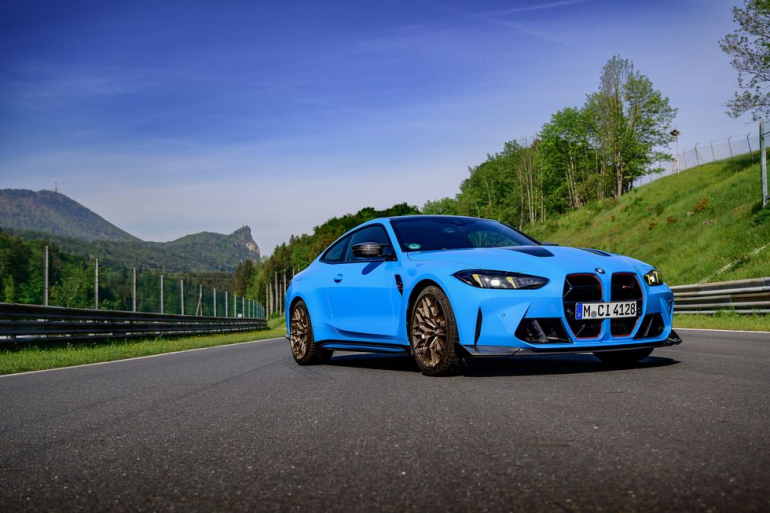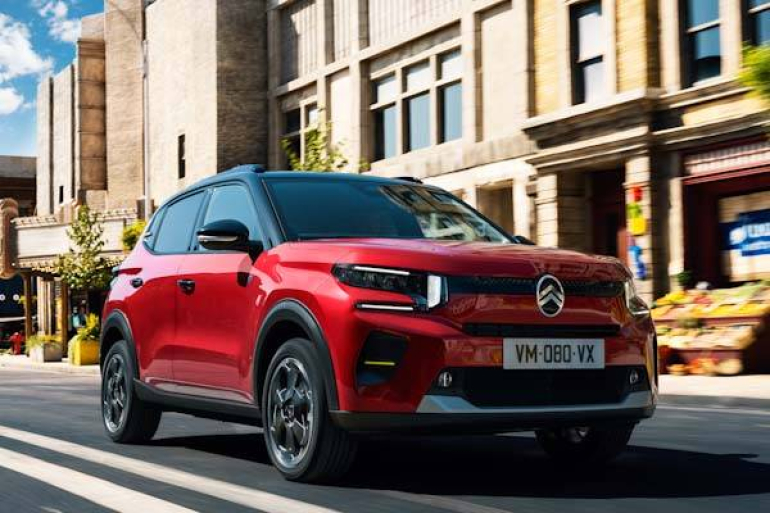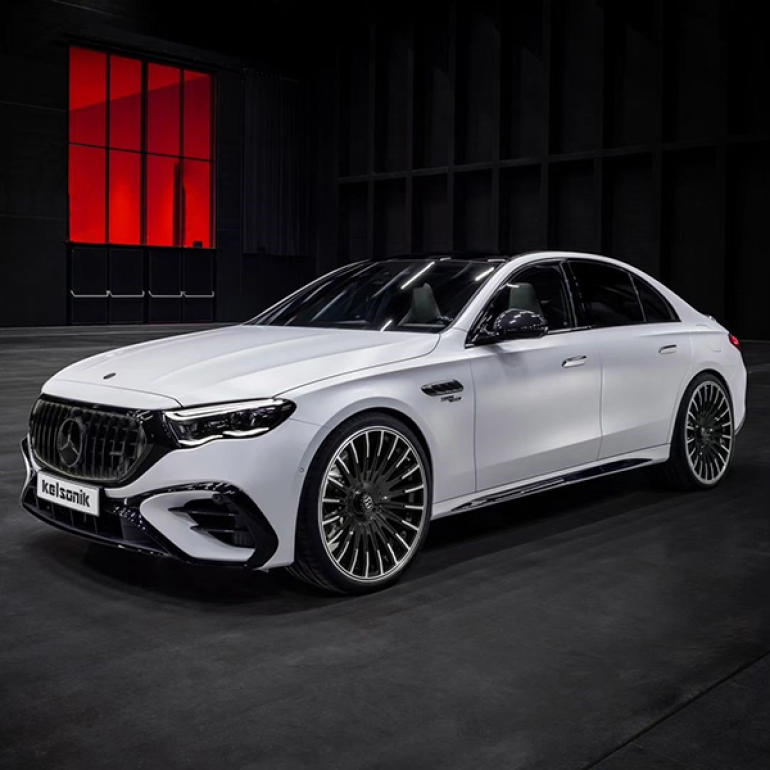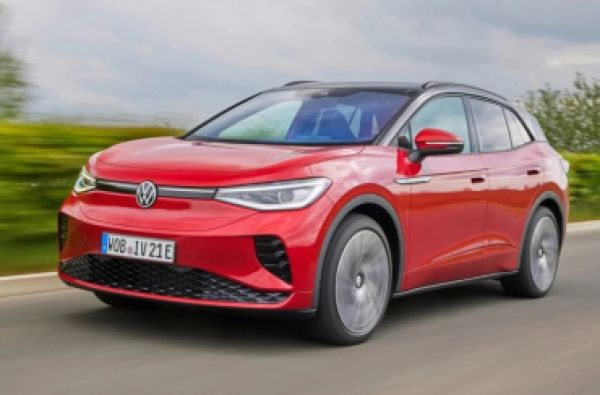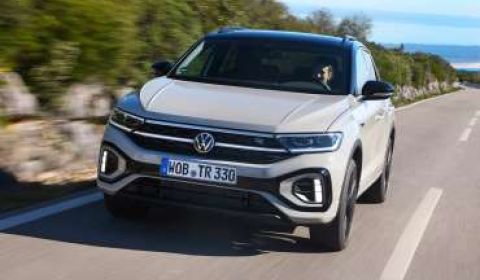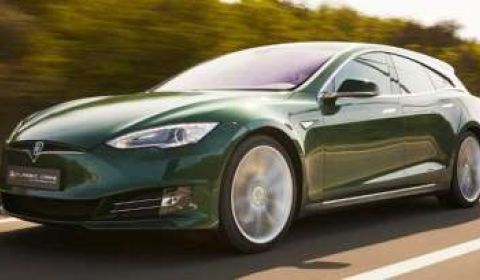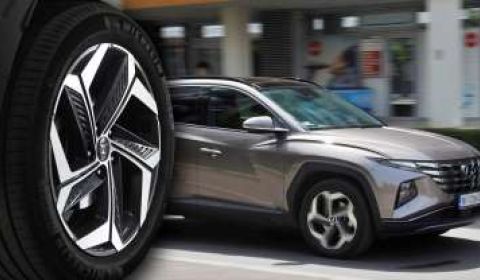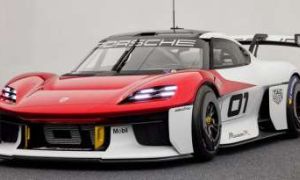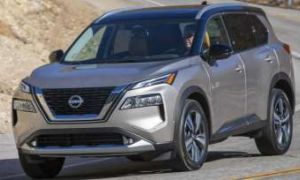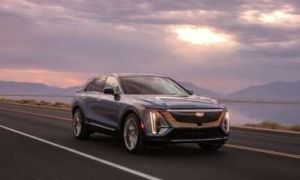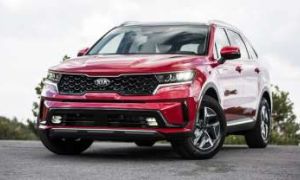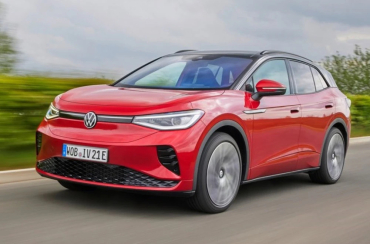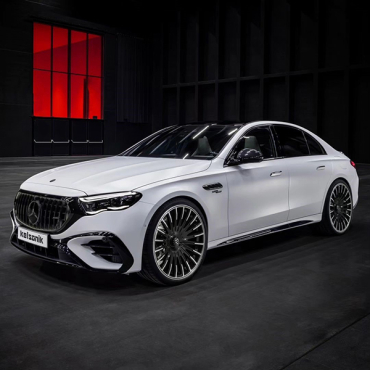
Worldcarblog.com
Volkswagen is recalling almost 80,000 ID.4 models
Volkswagen has recalled nearly 80,000 electric vehicles due to a software glitch that causes the screens to remain off.
This applies to the US, whose National Highway Traffic Safety Administration (NHTSA) announced that "this error may result in the loss of information about the speedometer or cameras".
The recall applies to electric vehicles ID.4 models made from 2021 to 2023.
It warns that camera failure increases the risk of collisions or other accidents when the vehicle is in reverse, and that blacked-out cabin displays can also increase the risk of accidents.
VW said there have been no reported accidents caused by the problems, although 354 warranty claims have been made.
2025 BMW M4 CS: Progress Is a Fickle Thing
The 543-hp CS matches the discontinued M4 CSL for panache and performance. But is it really worth $35,200 more than the 523-hp M4 Competition xDrive?
Although it cost a whopping $140,895 and was too hardcore overall to qualify as a daily driver, the dramatically dynamic, ultra-sharp-handling, and wildly dressed-up BMW M4 CSL (limited to 1000 units) sold out instantly after its 2022 reveal. Almost exactly two years later, BMW just launched the equally eye-catching M4 CS, priced at $124,675. Despite the extensive carbon-fiber treatment, trademark quad headlights with yellow lenses, a choice of drop-dead gorgeous satin black or golden forged-alloy wheels, and acres of contrasting black go-faster accents, the CS is actually not nearly as extreme in character and execution as its forerunner. After all, it features four proper seats instead of two solitary racing buckets; a commendably compliant chassis setup instead of a lowered, ultra-firm, track-focused suspension; and all the expected luxury equipment instead of a no-frills full-noise cabin.
Both models share the brand's iconic top-of-the-line twin-turbo 3.0-liter straight-six rated at an identical 543 horsepower and 479 pound-feet of torque. But thanks to its standard all-wheel drive, the M4 CS beats the no-longer-available rear-wheel-drive M4 CSL to 60 mph; BMW quotes a 3.2-second time versus 3.6 for the CSL, but considering the mechanically similar M3 CS sedan did the deed in 2.7 seconds, we reckon BMW's estimates are rather conservative. To carve out the CS's extra performance, the M power brokers dialed up the maximum boost pressure to 30.5 psi, which duly increased output by 20 horsepower. In a parallel move, the engineers took out more than 70 pounds of weight. Means to this end include a lighter exhaust with a titanium silencer, redesigned low-carb wheels, a carbon-fiber hood, various slimline splitters and spoilers, four yawning grille-less nasal air intakes, and a decontented center console.

We drove the M4 CS on the Salzburgring circuit in Austria, a two-hour drive from Munich. Mixed weather ruled out the Michelin Pilot Cup 2 R track-oriented tires, which are a factory option. Instead, our Riviera Blue companion for the day was shod with Pilot Sport 4S summer rubber, size 275/35ZR-19 up front and 285/30ZR-20 in the back. A little over 2.6 miles long, the Salzburgring is essentially a pair of fast straights capped by a set of slower curves on the approach to the start-finish line and the tricky high-speed 90-degree Nockstein Corner at the western perimeter. Constantly changing radii and several elevation changes make this 'Ring more challenging than the straightforward layout suggests. Sven Esch, driver of our pace car and senior vehicle dynamics engineer of the M4 CS, knows this natural proving ground inside out. He calls out his instructions: "No 2WD, please. Feel free to dial in Track mode and MDM, but do not switch off DSC." Aye, aye, sir!

The M4 CS is fitted with thinly padded one-size-fits-some bucket seats as standard equipment. Their cushioning effect is negligible, but together with the three-point seatbelts they keep even extra-large frames firmly in place during hard braking or ten-tenths turn-in maneuvers. The steering wheel, unnecessarily squared off at the bottom, boasts a red straight-ahead marker but is almost too thickly rimmed for standard-size paws. The eight-speed transmission knows three operating modes: Auto, Sport, and Manual. We opt for the latter and select the fastest of three shift velocities, which is rapid and punchy but not nearly as wham-bang brutal as the flat-out second-to-third Sport+ whiplash in a 911 GT3. Which is exactly the point: The M4 CS will never scare you like the CSL, which loved to live its life on a razor's edge in the wet and could still be snappy and short-tempered in the dry.
Even the long back straight is not long enough to reach the claimed 188-mph top speed. We saw an indicated 144 mph before dropping the (extra-cost) carbon-ceramic anchors, which start making a difference after the second or third stint with the crowd on the pit wall still cheering. The brakes, the springs, the dampers, and the anti-roll bars all were tuned specifically for the CS. Track mode further speeds up the throttle response, sends an extra smidgen of torque to the rear wheels, delays stability control interference by a fraction of a second, and flexes the chassis muscles at the limit more energetically.
One's favorite dynamic profiles can be stored and summoned via two fire-red steering-wheel buttons labeled M1 and M2. M1 could, for instance, lock all systems in Sport or Sport+ with DSC off, while M2 may serve as a low-grip default setting with the full safety net in place at all times. Unlike Porsche, BMW M even lets the driver tweak the key dynamic man-machine interfaces, namely steering response and brake action. Although the difference between Comfort or Sport is relatively subtle, we would prefer a stable feedback under all driving conditions. It is in this context worth mentioning that BMW steering has over time gradually lost some of that deeply reassuring connectivity and total haptic immersion that peaked in the legendary E46 M3. Even in a sharp-handling and commendably involving sports coupe like the M4 CS, electric actuation and electronic control has to an extent traded crispness and sparkle for reduced effort and enhanced safety.

Having said that, the M division's latest effort still is a highly emotional piece. Hit the red starter button, watch the digital displays pop into life one after the other, listen to the exhaust at idle, then blip the throttle and compare the sound to the selected drive mode. Too subtle? Hit the exhaust button, dial in Sport+, then check again. That's better. Now, pull the gear-lever into Drive and take off. What's next, Herr Esch—another qualification lap or a long run? Although the vocal inline-six redlines at 7200 rpm, the torque curve plateaus from 2750 to 5950 rpm, warranting plenty of midrange grunt. The shift lights on top of the speedometer and the tach instantly reflect every change of rhythm, but unfortunately the instruments retain silly square bracket graphics rather than more readable old-fashioned round dials. Although BMW removed the center armrest without asking for permission, at least the iDrive controller survived as a comforting fixture for touchscreen haters.
Two five-lap runs and some bonus track time doesn't sound like nearly enough to evaluate a new car, but then the M4 CS is in essence a familiar quantity spruced up with a few fresh talents. Although it looks like a facelifted CSL, its road manners, ride comfort, performance, and equipment are more like an M4 Competition xDrive's with a twist. Trouble is, that twist will cost you an extra $35,200, which is a lot of bread even if the production run will end, as rumored, after only one year and 2000 units, thereby likely bolstering the resale value. But right here and now, a base model M4 with standard seats and a wider choice of options seems like the more compelling bet. Feel free to save even more by opting for the 503-hp $84,375 rear-wheel-drive version, or secure a future classic in the shape of the 473-hp M4 manual priced at $80,275. Although the CS is the perfect 10 that beats the rest of the range on merit and appeal, that wafer-thin dynamic advantage comes at an uncool premium.
Specifications 2025 BMW M4 CS
Vehicle Type: front-engine, all-wheel-drive, 4-passenger, 2-door coupe
PRICE
Base: $124,675
ENGINE
twin-turbocharged and intercooled DOHC 24-valve inline-6, aluminum block and head, direct fuel injection
Displacement: 183 in3, 2993 cm3
Power: 543 hp @ 6250 rpm
Torque: 479 lb-ft @ 2750 rpm
TRANSMISSION
8-speed automatic
DIMENSIONS
Wheelbase: 112.5 in
Length: 189.0 in
Width: 75.5 in
Height: 55.1 in
Trunk Volume: 16 ft3
Curb Weight (C/D est): 3850 lb
PERFORMANCE (C/D EST)
60 mph: 2.7 sec
100 mph: 6.4 sec
1/4-Mile: 10.7 sec
Top Speed: 188 mph
EPA FUEL ECONOMY (C/D EST)
Combined/City/Highway: 18/16/22 mpg
Source: caranddriver.com
We know when the Hyundai hydrogen supercar will arrive PHOTO
Hyundai plans to start production of its first hydrogen supercar, and now it is known when the first examples should arrive.
This model will be called N74 and will arrive in 2026, in a limited series, reports the Korean newspaper Economic Daily.
As for the car itself, it is a coupe with "seagull" doors and rear-wheel drive.

The concept has a powertrain that delivers around 680 hp, while, when production starts, the series models will have as much as 780 hp, and will reach "100" in three seconds, writes the Korean paper.
Within two years (2026-2028), 200 copies should be produced, and the price will be 338,000 euros.

European avenger: Jeep Avenger gets four-wheel drive PHOTO
Jeep Avenger was presented in Europe for the first time in 2022, and it is made in the Tichy factory in Poland. Now, a new version is coming.
The current model is only offered with front-wheel drive, but now the Jeep Avenger 4xe will get all-wheel drive.
At the heart of this crossover is a 1.2-liter gasoline engine alongside two electric motors, which complement the hybrid technology. In total, the car delivers around 190 hp, with a six-speed automatic transmission.
Jeep says that the Avenger 4xe reaches 100 km/h in 9.5 seconds, and at speeds up to 30 km/h, the drive is always distributed 50/50. After that, the drive goes to the front wheels, but the rear ones can always "kick in" if needed.
In addition to this, the refreshed Jeep Avenger also received better physical performance, i.e. it was adapted for even more demanding off-road driving than before.
The car should arrive on the European market before the end of the year, and will join a hybrid and all-electric model with drives exclusively on the front wheels.
Citroen E-C3 review
Ten Second Review
Citroen's E-C3 aims to redefine what a small EV can be. And makes most other compact electric hatches look needlessly expensive. The brand's smallest hatch gains a crossover vibe - and a new-found fresh direction.
Background
So. Affordable electric motoring for the masses. We been promised that before. But this car, Citroen's E-C3, might just get a little closer to it. The starting price point of just over £20,000 isn't much different to that of its most obvious competitor, the Dacia Spring, but unlike that rival, the E-C3 is a proper five-seater and has a significantly higher driving range. Which is why Citroen feels it can describe this model as 'the most affordable proper electric car on the market'. It's also European-built, unlike the Chinese-made Dacia.
This is the fourth generation of C3 we've seen, a line-up that will also include a (significantly cheaper) conventional petrol version. It's a model range that accounted for over 40% of Citroen's total sales in its previous generation, so it could hardly be more important. This time round, there's a chunkier crossover vibe which will initially rather duplicate what the brand offers with its existing C3 Aircross until the company relaunches that model as a seven-seat SUV. The E-C3 will be key to Citroen's realignment going forward as an affordable electric mobility brand. Let's take a closer look.
Driving Experience
To achieve its low asking price, the E-C3's engineering is quite different from that of similarly-sized but much more expensive Stellantis Group models like the Vauxhall Corsa Electric and the Peugeot E-208. First, it has an electrified version of the simpler 'Smart Car' platform the brand developed for emerging nations in India and Latin America. Second, it uses an 'LFP' 'Lithium Ferro Phosphate' battery pack, instead of the more usual lithium-ion one, LFP packs being cheaper to produce, partly because they lack cobalt. The downside to the LFP tech is extra weight, though the E-C3's 44kWh pack is still rated at 199 miles, well ahead of its Dacia Spring market rival. There's a possibility of a smaller-battery variant with a lesser 124 mile range for the future.
The volume 44kWh version has a 111bhp electric motor on the front axle, propelling the car to 62mph in around 11s en route to 84mph. Ride comfort is a traditional Citroen attribute, so the Advanced Comfort shock absorber hydraulic bump stops from larger models are carried over to this one. The remainder of the damping set-up is conventional, with MacPherson strut front suspension and a torsion beam rear end. For those still unconvinced by (or unprepared to pay the price for) EV technology, Citroen will offer its usual 1.2-litre three cylinder petrol engine as part of this fourth generation please C3 line-up, with a choice of manual or automatic transmission.
Design and Build
Those familiar with the C3 model line will immediately notice that this time round, curvy cuteness has been swapped for a boxier, crossover-inspired more mature vibe. Which may be what the market wants but potentially makes this model a much less distinctive and individual proposition. To try and preserve some of that, there are styling cues from the wacky Oli concept car, an unusual bluff nose section with the brand's latest badge and 'colour clip' inserts on either side of the car which allow owners to add swappable, colour-contrasting accents. This C3 is only 80mm longer and 6mm wider than the old MK3 model, but sits 70mm taller.
Inside, it's nothing like any Citroen interior you've ever seen before. There's no instrument binnacle for a start. Only what the brand calls a 'head-up display', which actually isn't that at all; instead, it's a narrow letterbox-like strip which houses a small selection of digital instruments, primarily speed and range. This works with the almost equally unusual oblong-shaped over-buttoned steering wheel. Avoid base trim and you get a central infotainment screen, a 10-inch monitor that at last Citroen has learned not to over-burden with climate controls, which are separated out lower down. Fabric inserts and novel detailing supply the required Gallic vibe, as do the squashy Active Comfort seats.
At the back, where the budget vibe is emphasised by wind-up windows on most models, you shouldn't expect rear seat legroom to be any better than the previous generation model, but the boxy silhouette should mean improvements in headroom. This ought to benefit boot space too. The battery compartment under the rear seat has been altered to a T-shape to enhance trunk capacity, rated at 310-litres.
Market and Model
E-C3 pricing starts at under £23,000 and there's a choice of three trim levels - 'You!', 'Plus' and 'Max'. If the smaller-battery version makes it to the UK with its 124 mile driving range, that could be priced from under £18,000. For some perspective, we'll also tell you that Citroen are targeting a starting price for the 1.2-litre PureTech combustion petrol version of this car of around £15,000.
All models get the brand's Advanced Comfort suspension, along with manual air conditioning, rear parking sensors and auto headlamps. Base 'You!' spec does without the central infotainment display but with this variant, Citroen does provide a docking point for your phone. Most EC-3 customers will start their perusal of the line-up from mid-spec 'Plus' level, which includes 17-inch alloy wheels, squashier Advanced Comfort seats, two-tone paint and a 10.25-inch central infotainment display with 'Apple CarPlay' and 'Android Auto' smartphone-mirroring. Top 'Max' spec adds LED tail lights, navigation, a wireless charging mat, a rear parking camera tinted rear glass, automatic air conditioning and rear electric windows.
Across the line-up, there are some trendy options and the main one you'll want to look at would be the swappable colour-contrasting accents you can add to the car via two 'colour clip' inserts. Three paint choices will initially be available - orange, neon green and white, with a wider palette of shades available as the range expands.
Cost of Ownership
Range figures for EVs usually need to be taken with a degree of scepticism and that'll certainly be the case here, particularly if you'll be driving your E-C3 in very cold conditions. The LFP 'Lithium Ferro Phosphate' battery's more sensitive to external temperatures than a more usual lithium-ion battery would be, so you can expect the claimed 199 mile range figure for the 44kWh model to plummet in the depths of winter. You can't compensate with a heat pump either because that won't be offered here. The driving range though, should still be comfortably ahead of the 137 mile figure claimed for a rival Dacia Spring. To give you some class perspective, much pricier Stellantis Group EV superminis like Vauxhall's Corsa Electric and Peugeot's E-208 with their more conventional 51kWh batteries deliver around 248 miles of range.
Citroen claims that the E-C3 is capable of rapid charging at rates of up to 100kW, which allows for a 20-80% charge in 26 minutes. At home, you'll be able to AC charge from 20-80% from 7.4kW garage wall box in just over 4 hours. If your property has a three-phase supply, you'll also be able to charge at 11kW, in which case the 20-80% charging time will fall to just under 3 hours. We don't yet know whether Citroen will be importing the smaller-battery E-C3 with its 124 mile range. All versions of this model will be covered by the brand's usual unremarkable three year/60,000 mile warranty, plus the battery will have its own eight year cover package.
Summary
It's clever to make a small, usable, fashionable electric car. But it's even cleverer to make it affordable in the way Citroen has with this E-C3. The company's future as an affordable mobility brand starts right here. This car could (and was expected to be) merely a repackaged version of other Stellantis Group small hatches like electric versions of the Vauxhall Corsa and Peugeot 208. Instead, it's a lot more - for a lot less.
Not everyone will like the squarical new looks or the divisively-styled cabin but customers are tolerant of individualistic design in this part of the market and those who like it will probably love it. We can't really see why you'd pay almost as much for the cheaper-feeling rival Dacia Spring with its feebler operating range. And we'd certainly think twice about paying vastly more for a more conventional electric supermini. We're still not being served up a small EV for the masses here, but the E-C3 gets closer to that goal than any car before it.
Source: rac.co.uk
2024 Mercedes-AMG E 53 With New Taillights & Two Types Of New Wheel
New Mercedes-AMG E53 with new taillights and two types of new wheels. Which one is better?
Although I’m really not a fan of Audi because I consider 99% of its designs too darn boring, I have to admit that the C8-generation RS 6 Avant tucks at the right strings for me – even more so than the newer W/S/X 214 Mercedes-Benz E-Class or the G60/61 BMW 5 Series and their respective upcoming AMG and M variants.
Probably, as far as the Audi RS 6 Avant is concerned, it’s the right combination of practicality and untainted 4.0-liter twin-turbocharged V8 performance, which reaches up to 621 hp and 850 Nm (627 lb-ft) of torque in RS 6 Avant performance or GT edition trim. On the other hand, I’m not so sure the Mercedes-AMG versions with inline-six and electric aids can keep up the pace or that the continued use of the mighty V8 can offset the rumored (elephant) weight of the BMW M5.

Of course, I’m going to reserve judgment for that time when the Mercedes-AMG E 63 S E-Performance and the BMW M5 (Touring) are both out and about trying to fight off the Audi RS 6 Avant performance or GT special edition. Until then, at least, I am letting myself be persuaded that if everything falls flat, at least there’s a ‘soft’ Mercedes-AMG anyone could live with – the recently announced E 53.
However, some caveats do apply here, too, which is why I’m going to need a little bit of assistance from the imaginative realm of digital car content creators to resolve the conundrum. Officially, Mercedes-AMG announced the latest E 53 in March 2024 with a 3.0-liter inline-six and an electrified setup that is capable of delivering more oomph than the classic V8 – 577 combined hp or 604 ponies when the Race Start function is engaged.
There’s also the AMG Performance 4Matic+ fully variable all-wheel drive as standard, along with some pretty bonkers performance figures – zero to 60 mph (97 kph) in 3.7 seconds (with Race Start), while top speed reaches 174 mph (280 kph) or 87 mph (140 kph) in pure electric driving mode. There’s also a 21.2-kWh (usable capacity) battery so that it can run silently for a while. Alas, the issues don’t necessarily cover the powertrain but rather the design.
It seems that nobody dares to do anything about the ‘drippy’ eyes, but at least Nikita Chuicko, the virtual artist better known as kelsonik on social media, thinks now is the right CGI time to play with the Mercedes-AMG E 53’s awkward starry taillights. So, in his latest set of unofficial renderings, he simply reworked them into normal, sane-looking LED elements and also dropped a couple of new, larger aftermarket wheels – one dual-tone black-and-white and another more luxurious, dressed in gold. So, which is your favorite?
Source: mercedes-world.com
Tesla lowers car prices in Europe as well
The company Tesla has announced a big reduction in the prices of its vehicles in China and Germany, not long after it did so in the United States of America.
The latest price cut is another attempt for Ilona Musk's company to deal with declining sales and increasingly strong competition in leading markets, reports CNN.
The drop in prices reduced Tesla's profit margins, which also led to a drop in its shares by about four percent.
The world's largest manufacturer of electric vehicles on Sunday reduced the starting prices of four models in China, its largest overseas market, by 14,000 yuan, or about 1,810 euros.
The Model I, Tesla's best-selling car in China, is now on sale at an all-time low of 249,900 yuan (€32,384).
In Germany, Tesla's biggest market in Europe, the price of the rear-wheel drive Model 3 has also been reduced by 2,000 euros to 40,990 euros, according to the official website.
The first cuts were announced in the US on Friday, when Musk's company lowered the prices of three of its five models.
Tesla shares have fallen more than 40 percent since the start of the year, after quarterly car shipments fell for the first time in nearly four years, and the company also announced layoffs of about 10 percent of its workforce worldwide.

